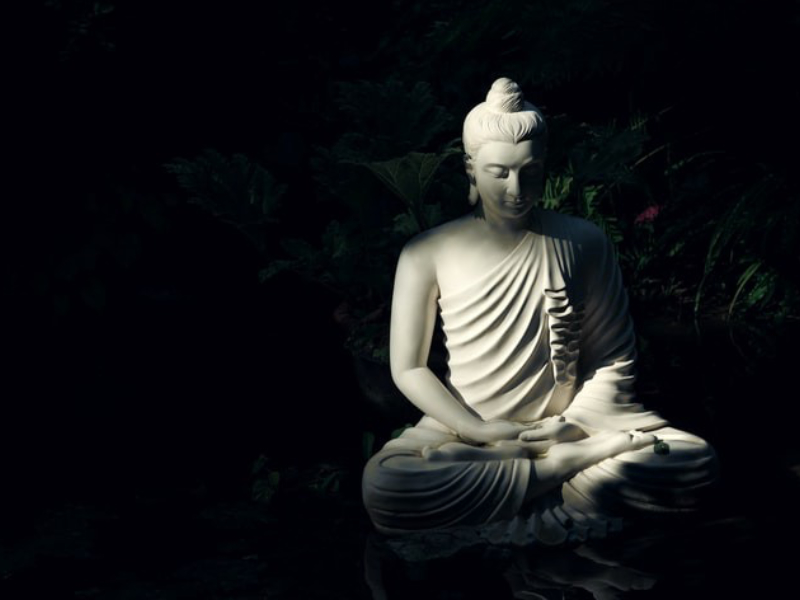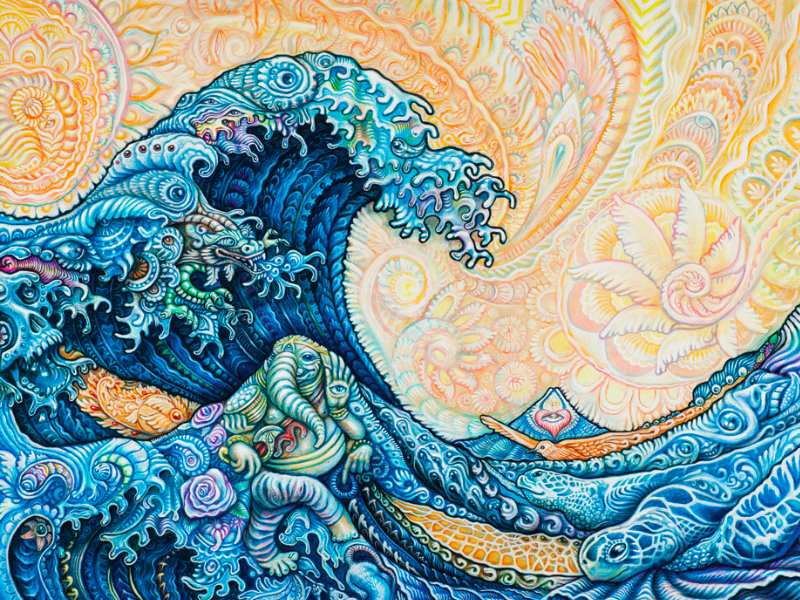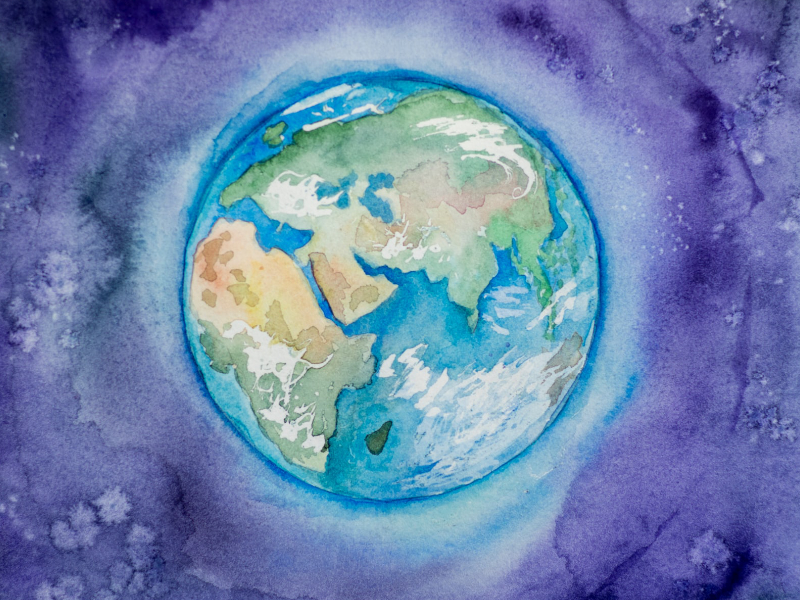The Noble Eightfold Path
– A Way to Transform Your Suffering –

A useful philosophy contains more than a collection of words. The words must be made flesh. They must be lived. They must be embodied, felt, and experienced.
Today, then, I will pick up from where I left off with the Four Noble Truths, which provides the conceptual framework for the Buddha’s life philosophy. And then, once we’ve refreshed ourselves a bit, I will move into the Noble Eightfold Path, which asks us to live this understanding.
Recap | The Four Noble Truths
Alright. Let’s quickly recap what we learned. First things first, it’s important to remember that the Four Noble Truths hold the intention underlying the Buddha’s entire philosophy — that intention being to understand and alleviate the suffering in the world. Without understanding this aim, we can’t get very far since it holds the entire framework.
With this aim in mind, the Buddha then opens our eyes, hearts, and ears to four important things about our precious human experience, truths not to be accepted dogmatically but to be examined and understood directly for ourselves. They are:
- Suffering or Dis-ease
- The cause of suffering
- The possibility of alleviating the cause of suffering
- A path or practice that leads away from suffering
In my last article, we explored the first three of these truths in depth. And though I provided some practical ways to explore these truths in our own lives, it was largely a conceptual exploration. But as I’ve said, a conceptual framework alone is not enough. Philosophy is not a dry intellectual pursuit. It is a love and passion for wisdom. It asks us to live our understanding.
That brings us to the Fourth Noble Truth, the truth of a path that leads away from suffering — the Noble Eightfold Path.
The Noble Eightfold Path
Together, the Four Noble Truths and the Noble Eightfold Path form an indivisible whole called the Dharma, which we can think of as the Truth, the Law, Nature, Life. Dharma practice, then, asks us to live in peace and harmony with the Dharma.
Now, it’s important to remember that our frame is grounded in suffering here. So, if we’re looking at truth or reality, we have to admit that suffering is apart of it. Dharma practice, then, asks us to live in peace with the truth of our own suffering. It therefore invites us to open to our suffering. It asks us to be interested in it, so we can understand its causes and conditions, so we can see how it arises and how we so often collapse into it.
I invite you to practice the Dharma and see for yourself the power this direct understanding has to transform your suffering. Let your suffering unfold into a free, open, and creative expression of love, joy, peace, and compassion.
Okay, well, enough preamble. What is the practice? Well, it is divided into three arenas of training: (1) a training in wisdom, (2) a training in ethics, and (3) a training of the mind.
Wisdom Training | Worldview
Today, we’re going to discuss the first of these three arenas of training — wisdom. Wisdom training, in the Buddhist framework, consists of two components: (1) the cultivation of a worldview or understanding that is based in truth or reality, and (2) the cultivation of thoughts that align with this worldview or understanding. But today, I’m only going to talk about the first since, in this little bit, there is already so much to chew on and digest.
Worldview & Understanding
Everything unfolds from understanding. What we believe to be true shapes everything. It shapes how we think, it shapes how we talk and act, it even shapes how we experience the world.
The entire path, then, begins here with our worldview. It begins with an understanding of ourselves, the world, and our place in the world. This is what orients us and sets our direction on the path.
In his own pursuit of understanding, the Buddha held two worldviews or two sets of lenses, which he wore like bifocals to look at the world. He called these two lenses or worldviews: (1) the worldly or relative view, and (2) the ultimate view. And of course, as always, the Buddha does not ask you to take these worldviews on authority. He invites you to explore them for yourself.
Wordly View. With the worldly view, the Buddha explored the Hindu notion of karma and noticed that actions not only have internal and external consequences, but that the seeds of these karmic results lie in the intention and motivation at the root of our actions.
When our intentions are motivated by generosity, loving-kindness, and wisdom, the karmic result is a sense of ease, peace, happiness, and love. When our intentions are motivated by greed, hatred, and delusion, the karmic result is dis-ease, agitation, discontent, and suffering. Again, this is not something to take on dogma, but rather it is an invitation to know this through your own direct investigation.
What’s cool here is that when we put this understanding into practice, we gain a kind of creative freedom in our lives. When we realize that our intentions and motivations shape how our inner lives unfold, we can begin to paint our own lives. We can take responsibility for our own wellbeing.
This, of course, is it’s own practice, a practice that lasts a lifetime. But each step you take here will move you in the direction of ease, peace, happiness, and love. Your life will continue to climb upward. And, what’s more, is that this worldview or understanding of karma in your own personal life will eventually become a bridge into the Buddha’s next worldview — the ultimate view.
Once your heart and mind have softened and opened through the practice of goodwill, a remarkable sense peace will sprout from within. And as a natural consequence of this peace, your mind will become more focused, bright, and vivid, which will then allow you to look more deeply at the Dharma, including the nature of your own mind.
In other words, once you cross this bridge, your eyes of wisdom will open and you will get a glimpse of true freedom or Liberation.
Ultimate View. With the ultimate view, the Buddha looked beyond himself, he looked beyond the chain of karma, beyond the relative world, beyond the world of concepts, until he penetrated the ultimate nature of reality. Here, he realized there exists only a seamless, interconnected world of constant change. And what’s more is that, in a world of constant change, there is nothing that can reliably be called self. The world is entirely whole.
When we look closely at experience, we can witness directly for ourselves this undivided whole. We can see, feel, and know that everything is in constant flux, seamlessly interconnected. We too can witness that there is nothing stable enough to call ‘self’.
We can see that the appearance of things is just that — an appearance, a chimera that arises when awareness collapses into thought. But when we step back, when we orient from that which is aware of thought, we can see that thoughts are arising, changing, and being known in awareness, which is open, formless, boundless, and free.
When we examine the nature of thought, we can understand that thoughts are what break the world into pieces and relate them to one another. But outside of thought, there exist no boundaries or separations anywhere. Outside of thought, there are no lines that divide the earth into states, nations, and countries. Outside of thought, there is no good and evil, no right and wrong, no pleasant and unpleasant. Outside of thought, there is no up and down, no left and right, no backward and forward. Outside of thought, there is no space and time, no objects and things, no self and other. There is only the world, a seamless, interconnected whole.
There’s just It, whatever It ineffably is.
Look closely at the nature of thought, and witness directly for yourself that each thought is nothing more than a passing cloud of energy in the mind. Look past thought and realize that you are not and cannot be that which arises in thought. Look directly at your own mind, and know for yourself that you are entirely open and free. You are already at peace.
The Buddha’s ultimate view invites us to ground ourselves in this truth, to live from the direct understanding of impermanence, selflessness, and whole-ness or oneness. This is where true transformation happens, by witnessing directly again and again the impermanent, selfless, interconnected nature of reality. This is seeing and living with wisdom.
And it is this — the eye of wisdom — that leads to the liberation of suffering. It is this that brings about a fundamental shift in our moment-to-moment perception. It is this that allows us to become living expressions of love, joy, compassion, and peace.
But because, in the beginning, we only get glimpses of this awakening, because we so easily fall back into our old habits and beliefs, we still need to cultivate this awakening gradually. We still need to practice holding this awakening steady and continuous for longer and longer periods of time.
True freedom lies in cutting through the illusion of self.
With devotion, practice, and patience, may you embody the deepest peace.
“Though my view is as vast as the sky, my attention to the law of karma is as fine as a grain of barley flour.” — Padmasambhava
More Articles
“The Art of Bare Attention”
Today we’re going to talk about the ancient Buddhist practice vipassana, or insight meditation. Now, just to be clear, this is an entirely secular practice. It doesn’t require you to adopt any dogmatic beliefs…
“The Faceless Seer”
How do you hold your love? Do you hold her from stillness, with nowhere to go, with nothing to do? How do you hold your love? Do you hold her with acceptance, with open hands and arms, with unabashed…
“Everything Changes”
It’s no secret everything changes. Your experience this morning isn’t your experience now. Yet how many of us act like we really understand this? How often do we grasp onto the illusion of things…
“The Divine Connection”
How do you hold your love? Do you hold her from stillness, with nowhere to go, with nothing to do? How do you hold your love? Do you hold her with acceptance, with open hands and arms, with unabashed…






